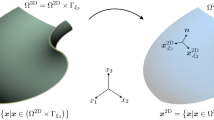Abstract
The approximate energy release rate for a crack which extends, or “kinks”, away from its original direction has been computed by finite element analysis using three different methods: stiffness derivative procedure, J integral method and crack closure integral procedure. A case study is presented to compare the computational accuracies. It suggests that a satisfactory approximation can be obtained provided that the ratio of kink length to original crack length, l(0)/a⩽0.04, despite the interaction of the crack tip and knee stress singularities.
Résumé
En utilisant trois méthodes différentes (dérivation de la raideur, intégrale J et intégrale de fermeture de la fissure), on a calculé par éléments finis la vitesse approchée de relaxation de l'energie dans le cas d'une fissure qui diverge ou qui part en arborescence par rapport à sa direction initiale.
On présente une étude de cas de manière à comparer les précisions respectives obtenus dans les calculs.
Cette étude suggère qu'une approximation satisfaisante peut être obtenue, pour autant que le rapport de la longueur déviée à la longueur initiale de la fissure soit inférieure ou égale à 0,04, en dépit de l'interaction entre l'extrémité de la fissure et la singularité de la contrainte.
Similar content being viewed by others
References
H. Andersson, Journal of the Mechanics and Physics of Solids 17 (1969) 405–417. See also the Erratum, Journal of the Mechanics and Physics of Solids 18 (1970) 437.
A.A. Khrapkov, International Journal of Fracture Mechanics 7 (1971) 373–382.
P. Palaniswamy and W.G. Knauss, International Journal of Fracture 9 (1972) 114–117.
K. Palaniswamy and W.G. Knauss, in Mechanics Today, Vol. 4, Academic Press, N.Y. (1978) 87–148.
M.A. Hussain, S.L. Pu and J. Underwood, in Fracture Analysis, ASTM STP 560 (1974) 2–28.
R.V. Goldstein and R.L. Salganik, International Journal of Fracture 10 (1974) 507–523.
S.N. Chatterjee, International Journal of Solids and Structures 11 (1975) 521–538.
B.A. Bilby and G.E. Cardew, International Journal of Fracture 11 (1975) 708–712.
B.A. Bilby, G.E. Cardew and I.C. Howard, in Advances in Research on the Strength and Fracture of Materials, Proceedings ICF4, Waterloo, Canada, Vol. 3 (1977) 197–200.
H. Kitagawa and R. Yuuki, Proceedings ICF4 (1977) 201–211.
V. Vitek, International Journal of Fracture 13 (1977) 481–501.
K.K. Lo, Transactions of ASME, Journal of Applied Mechanics 45 (1978) 757–802.
B. Cotterell and J.R. Rice, International Journal of Fracture 16 (1980) 155–169.
S. Melin, International Journal of Fracture 30 (1986) 57–65.
S.K. Maiti, International Journal of Fracture 32 (1986) R33-R36.
A.R. Zak and M.L. Williams, Journal of Applid Mechanics 30 (1963) 142–143.
P. Tong and T.H.H. Pian, International Journal of Solids and Structures 9 (1973) 313–321.
R.H. Gallagher, in Proceedings of First Conference on Numerical Methods in Fracture Mechanics, Swansea (1978) 1–25.
D.M. Parks, International Journal of Fracture 10 (1974) 487–502.
J.R. Rice, Transactions ASME, Journal of Applied Mechanics 35 (1968) 379–386.
E.F. Rybicki and M.F. Kanninen, Engineering Fracture Mechanics 9 (1977) 931–938.
T. Krishnamurthy, T.S. Ramamurthy, K. Vijayakumar and B. Dattaguru, in Proceedings of International Conference on Finite Elements in Computational Mechanics, IIT Bombay, India, (1985) 891–900.
T.S. Ramamurthy, T. Krishnamurthy, K. Badari Narayana, K. Vijayakumar and B. Dattaguru, Mechanics Research Communications 13 (1986) 179–186.
S.K. Mait, Proceedings of Workshop cum Seminar on Delaminations in Composites, India Institute of Science, Bangalore, India (1987) 63–84.
S.K. Maiti, In-plane fracture toughness of unidirectional fibre composites, Closure Report of the Sponsored Project, Mechanical Engineering Department, Indian Institute of Technology, Bombay, (May 1987).
R. Sethuramam and S.K. Maiti, Engineering Fracture Mechanics 30 (1988) 227–231.
M.L. Williams, Transactions ASME, Journal of Applied Mechanics 19 (1952) 526–528. See also “Discussion”, Journal of Applied Mechanics 20 (1953) 590.
K.J. Lau and C.L. Chow, in Proceedings of International Conference on Fracture Mechanics and Technology, Vol. II, Hong Kong, Sijthoff and Noordhoff (1977) 1529–1536.
Author information
Authors and Affiliations
Rights and permissions
About this article
Cite this article
Maiti, S.K. Finite element computation of the strain energy release rate for kinking of a crack. Int J Fract 43, 161–174 (1990). https://doi.org/10.1007/BF00018339
Received:
Accepted:
Issue Date:
DOI: https://doi.org/10.1007/BF00018339




